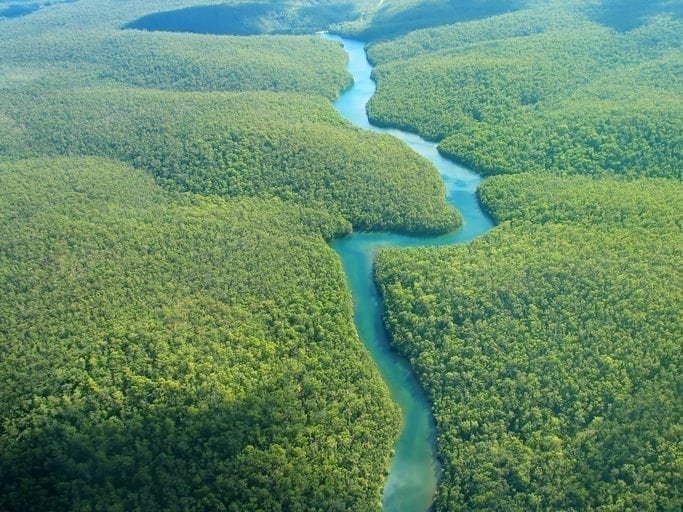New species highlights
The report, New Species of Vertebrates and Plants in the Amazon 2014-2015, consolidates the findings from a number of different researchers. Some of the most fascinating finds include:
A new species of pink river dolphin
Estimated to have a population of around 1,000 individuals, the species is under threat from the construction of hydroelectric dams and industrial, agricultural and cattle ranching activities. Pink river dolphins play an important role in the popular imagination and culture of the Amazon, and in the myths and legends which surround it.
A snake that looks like it has two pairs of eyes
Although small (around 40cm), this snake is eye-catching due to its colours and patterns. Its head is black, with a pale collar that resembles a broken necklace, so when seen from the top it recalls a pair of eyes. Its lips are white or yellow and it has a triangular mark behind its eyes.
Fire-tailed titi monkey
This striking monkey from the southern Amazon owes its name to its long bright orange tail. The species is under threat from deforestation.
A yellow-moustached lizard
This lizard is predominantly dark brown and has black stripes on the sides of its head. In the region of its upper mouth contour, on its head and neck, most scales are covered by a blazing orangish-yellow tinge. The name refers to the yellow tone of the upper lip of this species.
A blind snake that likes to bury itself
The snakes of this family have rudimentary eyes and they spend most of the time buried in the soil or under rocks. In this species, an eye-catching bright yellow tone completely covers the scales on the upper part of its head, as well as the terminal portion of its spine.
A freshwater honeycomb-patterned stingray
Found in the Brazilian state of Rondônia. Its dorsal pattern is usually dark brownish, with honeycomb-like speckles.
Colourful roadside pond fish
This annual fish was discovered in a roadside pond in Bolivia, which is the only known location where the species occurs. This beautiful fish has a predominantly reddish-brown colour, with white speckles spread over its body, and a blue hue on the distal part of its fins.
An enigmatic, nocturnal frog
This frog is nocturnal and inhabits open areas on the Venezuelan tepuis table mountain between altitudes of 1,800 and 2,600 metres above sea level. During the day, it is easy to find it on bromeliad plants, where it hides for long periods.
A curious electric fish
Found in a lowland floodplain of the River Amazon, this electric fish sends out weak electric charges which are incapable of causing harm to other fish. It can reach 1 metre in length, has a long snout, a small, toothless mouth and a unique colour pattern that consists of a series of dark rounded blotches which run horizontally along the side of its body. It is nocturnal and lives buried in the sand during the day.
A bird that pays tribute to the Brazilian rubber tapper
Discovered after its unknown call attracted attention, this bird’s name – Chico’s Tyrannulet – is a tribute to the rubber tapper and environmentalist Francisco Alves Mendes Filho. Better known as Chico Mendes, he was a leader of the rubber tapping communities and played a key role in opening the world’s eyes to the problems faced by the Amazon.
Click here to read WWF’s Living Amazon 2016 Report.
 Play Video about This Rock Might Just Save The World
Play Video about This Rock Might Just Save The World Play Video about Play 2 hours of rock
Play Video about Play 2 hours of rock Play Video about Play 2 hours of brook
Play Video about Play 2 hours of brook Play Video about Play 2 hours of sheep
Play Video about Play 2 hours of sheep











































